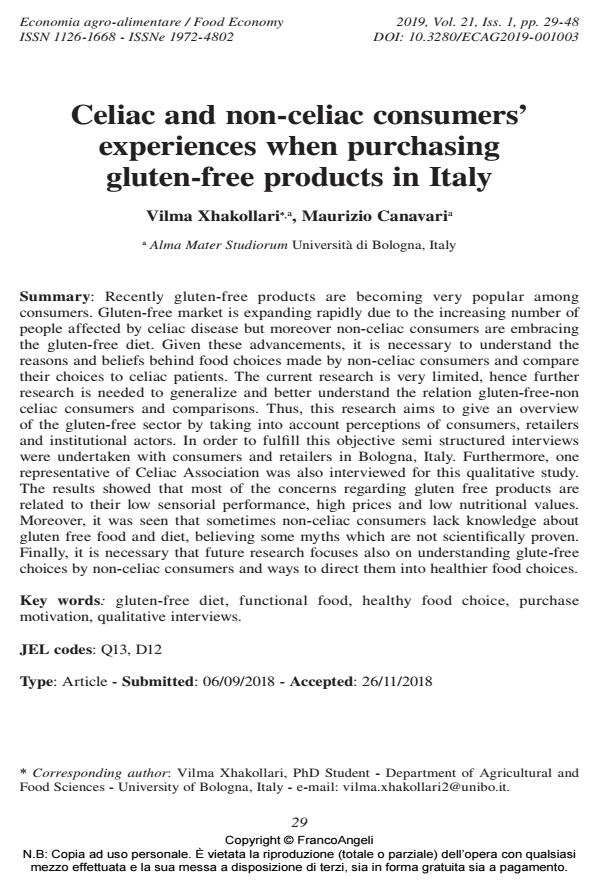Celiac and non-celiac consumers’ experiences when purchasing gluten-free products in Italy
Titolo Rivista ECONOMIA AGRO-ALIMENTARE
Autori/Curatori Vilma Xhakollari, Maurizio Canavari
Anno di pubblicazione 2019 Fascicolo 2019/1
Lingua Inglese Numero pagine 20 P. 29-48 Dimensione file 139 KB
DOI 10.3280/ECAG2019-001003
Il DOI è il codice a barre della proprietà intellettuale: per saperne di più
clicca qui
Qui sotto puoi vedere in anteprima la prima pagina di questo articolo.
Se questo articolo ti interessa, lo puoi acquistare (e scaricare in formato pdf) seguendo le facili indicazioni per acquistare il download credit. Acquista Download Credits per scaricare questo Articolo in formato PDF

FrancoAngeli è membro della Publishers International Linking Association, Inc (PILA)associazione indipendente e non profit per facilitare (attraverso i servizi tecnologici implementati da CrossRef.org) l’accesso degli studiosi ai contenuti digitali nelle pubblicazioni professionali e scientifiche
Recently gluten-free products are becoming very popular among consumers. Gluten-free market is expanding rapidly due to the increasing number of people affected by celiac disease but moreover non-celiac consumers are embracing the gluten-free diet. Given these advancements, it is necessary to understand the reasons and beliefs behind food choices made by non-celiac consumers and compare their choices to celiac patients. The current research is very limited, hence further research is needed to generalize and better understand the relation gluten-free-non celiac consumers and comparisons. Thus, this research aims to give an overview of the gluten-free sector by taking into account perceptions of consumers, retailers and institutional actors. In order to fulfill this objective semi structured interviews were undertaken with consumers and retailers in Bologna, Italy. Furthermore, one representative of Celiac Association was also interviewed for this qualitative study. The results showed that most of the concerns regarding gluten free products are related to their low sensorial performance, high prices and low nutritional values. Moreover, it was seen that sometimes non-celiac consumers lack knowledge about gluten free food and diet, believing some myths which are not scientifically proven. Finally, it is necessary that future research focuses also on understanding glute-free choices by non-celiac consumers and ways to direct them into healthier food choices. .
Parole chiave:Gluten-free diet, functional food, healthy food choice, purchase motivation, qualitative interviews
Jel codes:Q13, D12
- Why people follow a gluten-free diet? An application of health behaviour models Vilma Xhakollari, Maurizio Canavari, Magda Osman, in Appetite 105136/2021 pp.105136
DOI: 10.1016/j.appet.2021.105136 - Functional food consumption by Portuguese university community: Knowledge, barriers and motivators Paula Moutinho, Inês Andrade, Angela Macedo, in Economia agro-alimentare 2/2022 pp.1
DOI: 10.3280/ecag2022oa13258 - Consumer Characterization of Commercial Gluten-Free Crackers Through Rapid Methods and Its Comparison to Descriptive Panel Data Japneet Brar, Rajesh Kumar, Martin J. Talavera, in Foods /2025 pp.2972
DOI: 10.3390/foods14172972 - Relevant elements on biscuits purchasing decision for coeliac children and their parents in a supermarket context P. Puerta, L. Laguna, A Tárrega, E. Carrillo, in Food Quality and Preference 104496/2022 pp.104496
DOI: 10.1016/j.foodqual.2021.104496 - Against the Grain: Consumer’s Purchase Habits and Satisfaction with Gluten-Free Product Offerings in European Food Retail David Dean, Meike Rombach, Frank Vriesekoop, Philippe Mongondry, Hoa Le Viet, Sirasit Laophetsakunchai, Beatriz Urbano, Teresa Briz, Vilma Xhakollari, Güler Atasoy, Mahir Turhan, Stavroula Chrysostomou, Elena Hadjimbei, Hussein Hassan, Maya Bassil, Sanna Arnala, Dominika Głąbska, Dominika Guzek, Sophie van den Berg, Lilian Ossel, Amalia Scannell, Puja Rauniyar, Eirini Bathrellou, Meropi Kontogianni, Wim de Koning, in Foods /2024 pp.3152
DOI: 10.3390/foods13193152 - Exploring the sensory characteristics and understanding consumer acceptance of gluten-free pasta Vilma Xhakollari, Giulia Maria Daniele, Marta Cianciabella, Chiara Medoro, Veronica Paradiso, Maurizio Canavari, in European Food Research and Technology /2025 pp.1305
DOI: 10.1007/s00217-025-04706-0 - Are gluten-free products healthy for non-celiac consumers? How the perception of well-being moderates gluten-free addiction Cristina Zerbini, Francesca De Canio, Elisa Martinelli, Beatrice Luceri, in Food Quality and Preference 105183/2024 pp.105183
DOI: 10.1016/j.foodqual.2024.105183
Vilma Xhakollari, Maurizio Canavari, Celiac and non-celiac consumers’ experiences when purchasing gluten-free products in Italy in "ECONOMIA AGRO-ALIMENTARE" 1/2019, pp 29-48, DOI: 10.3280/ECAG2019-001003